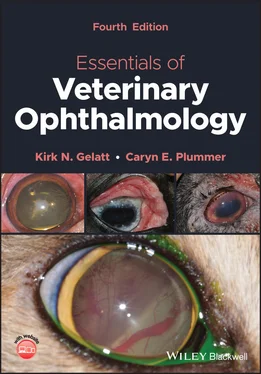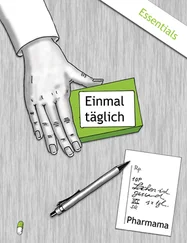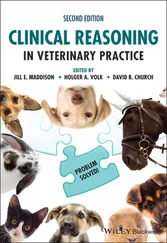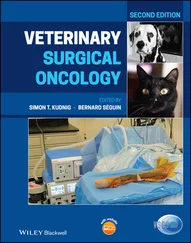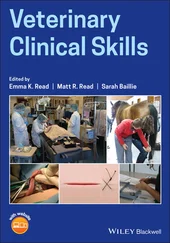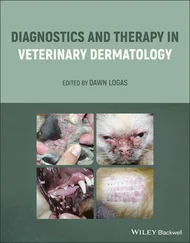
Table 2.10 IOPs in select animal species.
|
IOP results |
| Species |
Mean ± SD |
Tonometer |
Investigator |
| Alligator |
23.7 ± 2.1 |
TonoPen |
Whittaker et al. (1995) |
| Cat |
22.6 ± 4.0 |
Mackay‐Marg |
Miller et al. (1991b) |
| 19.7 ± 5.6 |
TonoPen |
| Cow |
28.2 ± 4.6 |
Mackay‐Marg |
Gum (1990) |
| 26.9 ± 6.7 |
TonoPen XL |
| Chinchilla |
3.0 ± 1.8 |
TonoVet‐D |
Müller et al. (2010) |
| 9.7 ± 2.5 |
TonoVet‐D |
Snyder et al. (2018) |
| Dog |
15.7 ± 4.2 |
Mackay‐Marg |
Miller et al. (1991a) |
| 16.7 ± 4.0 |
TonoPen |
| 17.8 ± 0.9 (pm) |
Mackay‐Marg |
Gelatt et al. (1981) |
| 21.5 ± 0.8 (am) |
|
|
| Ferret |
22.8 ± 5.5 |
TonoPen |
Sapienza et al. (1991) |
| 15.4 ± 1.1 |
TonoPen Vet |
Di Girolamo et al. (2013) |
| 14.1 ± 0.4 |
TonoVet |
| Frog (White's tree frogs) |
16.8 ± 3.9 |
TonoLab‐R |
Hausmann et al. (2017) |
|
14.7 ± 1.6 |
TonoVet‐D |
| Goat (pygmy) |
11.8 ± 1.5 |
TonoVet‐D |
Broadwater et al. (2007) |
| 10.8 ± 1.7 |
TonoPen XL |
| Guinea pig |
18.3 ± 4.6 |
TonoPen Vet |
Coster et al. (2008) |
| 6.1 ± 2.2 |
TonoVet |
| Horse |
25.5 ± 4.0 |
Mackay‐Marg |
Cohen & Reinke (1970) |
|
23.5 ± 6.1 |
Mackay‐Marg |
Miller et al. (1990) |
|
23.3 ± 6.9 |
TonoPen |
| Mouse (no anesthetic) |
14.6 ± 0.5 |
TonoLab |
Ding et al. (2011) |
| Nonhuman primate Rhesus (ketamine) |
14.9 ± 2.1 |
Pneumatonograph |
Bito et al. (1979) |
|
15.4 ± 2.6 |
TonoPen XL |
Komaromy et al. (1998) |
| Tibetan monkey |
29.3 ± 0.9 |
TonoVet‐P |
Liu et al. (2011) |
| Rabbit |
19.5 ± 1.8 |
Pneumatonograph |
Vareilles et al. (1977a, 1977b) |
| 17.9 ± 2.1 |
Smith & Gregory (1989) |
| 9.5 ± 2.6 |
TonoVet |
Pereira et al. (2011) |
| 15.4 ± 2.2 |
TonoPen Avia |
| Raptor |
|
|
|
| Red‐tailed hawk |
20.6 ± 3.4 |
TonoPen |
Stiles et al. (1994) |
| Golden eagle |
21.5 ± 3.0 |
| Great horned owl |
10.8 ± 3.6 |
| White‐tailed sea eagle |
26.9 ± 5.8 |
TonoVet |
Reuter et al. (2011) |
| Northern goshawk |
18.3 ± 3.8 |
|
|
| Red kite |
13.0 ± 5.5 |
|
|
| Eurasian sparrowhawk |
15.5 ± 2.5 |
|
|
| Buzzard, common |
26.9 ± 7.0 |
|
|
| Kestrel, common |
9.8 ± 2.5 |
|
|
| Falcon, peregrine |
12.7 ± 5.8 |
|
|
| Owl, tawny |
9.4 ± 4.1 |
|
|
| Owl, long‐eared |
7.8 ± 3.2 |
|
|
| Owl, barn |
10.8 ± 3.8 |
|
|
| Rat |
17.3 ± 5.3 |
TonoPen |
Mermoud et al. (1994) |
|
21.4 ± 1.0 |
TonoPen |
Sappington et al. (2010) |
| Sheep |
10.6 ± 1.4 |
Perkins |
Gerometta et al. (2009) |
Table 2.11 Factors that cause short‐ and long‐term fluctuations in IOP.
| Short‐term fluctuations |
Long‐term fluctuations |
| Diurnal changes |
Aging |
| Forced eyelid closure |
Race/breed |
| Contraction of retractor bulbi muscles |
Hormones |
| Coughing/Valsalva maneuver |
Glucocorticoids |
| Abrupt changes in blood pressure |
Growth hormone |
| Pulse |
Estrogen |
| Struggling/electroshock |
Progesterone |
| Changes in body/head position |
Obesity |
| Succinylcholine |
Myopia |
| Acidosis |
Gender |
|
Season |
Ocular rigidity is a constant characteristic of each eye, but it also depends on IOP. Hence, the distensibility of each globe varies among individuals as well as with the IOP. Dogs and cats have greater scleral elasticity than humans, so less resistance is offered with indentation tonometry, and buphthalmia occurs more readily with prolonged, increased IOP.
In many species, IOPs as measured with applanation tonometry in normal animals have been reported ( Table 2.10). In humans and animals, short‐ and long‐term fluctuations in IOP occur for a variety of reasons ( Table 2.11). Diurnal IOP variations generally occur in most species; in humans and dogs, the highest pressure occurs in the morning and the lowest in the afternoon. In contrast, the greatest IOPs occur during the day and the lowest IOPs are documented at night in the rabbit, cat, horse, and nonhuman primate. In glaucomatous canine patients, diurnal IOP fluctuations (as measured by tonometry) are typically much greater in comparison to normal dogs. Consequently, antiglaucoma medications administered once daily to dogs should be given in the evening to mitigate IOP spikes in the morning, when pressures are typically the greatest.
The second most powerful refracting structure in the eye is the lens. Like the cornea, the lens is a transparent tissue without a direct blood supply. The lens depends primarily on AH for its metabolic needs. Most of the lens proteins are soluble, with a small amount of glycoproteins, whereas the cornea consists mostly of insoluble collagen and a relatively large amount of glycoproteins. The lens considerations are important to the veterinary ophthalmologists when considering cataract surgery in animals, and attempts using intraocular lenses (IOLs) to re‐establish the best possible visual acuity. Lens metabolism is also important as the second largest group of dogs having cataract surgery are those with diabetes mellitus.
Lens epithelial cells are the progenitors of the lens fibers and transition into lens fiber cells of the cortex at the equator. This process is characterized by distinct biochemical and morphological changes, such as the synthesis of crystallin proteins, cell elongation, loss of cellular organelles, and disintegration of the nucleus.
Transparency of the lens depends primarily on the highly ordered lens cell arrangement, as well as on the solubility and physical arrangements of its proteins. The lens behaves as a cell syncytium both biochemically and electrically. The lens consists of approximately 68% water, 38% protein, and small amounts of lipids, inorganic ions, carbohydrates, ascorbic acid, glutathione, and amino acids.
The protein content of the lens is very high in comparison to other body organs. Protein synthesis ceases with formation of the lens fiber cells, and all the protein changes that occur after this stage are posttranslational modifications. Lens proteins are divided into water‐soluble proteins and water‐insoluble proteins. Crystallins comprise 80–90% of the water‐soluble lens proteins. Most of the insoluble proteins occur in the lens nucleus, whereas the soluble proteins are concentrated in the lens cortex. The insoluble proteins are associated primarily with membranes of the lens fibers; the soluble proteins comprise the bulk of the refractive fibers of the lens. With aging, water‐soluble proteins coalesce to make high molecular weight aggregates and their hydrophilicity diminishes. Additionally, when the lens becomes cataractous, the level of water‐insoluble proteins increases.
Читать дальше
